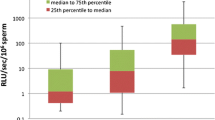Abstract
Purpose: Reactive oxygen species (ROS) including H2O2 produced by spermatozoa have been suggested, on one hand, to be associated with idiopathic male infertility and, on the other hand, to stimulate certain sperm function leading to fertilization. The influence of ROS on fertilization was investigated in 75 IVF patients by correlating fertilization rates with the production of ROS and the H2O2-scavenging activity of swim-up spermatozoa prepared in parallel with the IVF samples.
Results: Low rates of ROS production by the swim-up sperm was detected by the luminol-dependent chemiluminescence assay. They were not correlated with fertilization rates. The hydrogen peroxide scavenging capacity of these spermatozoa, measured as the removal of exogenous H2O2 assayed spectrophotometrically, decreased stepwise in groups of patients achieving higher fertilization rates, suggesting a positive effect of this ROS on fertilization. An alternative explanation of this correlation is plausible in view of the association of both high scavenging activities and poor fertilization rates with poor sperm morphology.
Conclusions: ROS produced by spermatozoa selected by swim-up plays no negative, if not a positive, role in fertilization.
Similar content being viewed by others
References
Riley JCM, Behrman HR: Oxygen radicals and reactive oxygen species in reproduction. Proc Soc Exp Biol Med 1991;198:781–791
Rice-Evans CA, Diplock AT, Symons MCR: Mechanism of radical production. InLaboratory Techniques in Biochemistry and Molecular Biology, Vol 22. Techniques in Free Radical Research, RH Burdon, PH Knippenberg (eds.). London, Elsevier, 1991, pp 19–50
Aitken RJ, Clarkson JS: Cellular basis of defective sperm function and its association with the genesis of reactive oxygen species by human spermatozoa. J Reprod Fertil 1987;81:459–69
Alvarez JG, Touchstone JC, Blases L, Storey BT: Spontaneous lipid peroxidation and production of hydrogen peroxide and superoxide in human spermatozoa—Superoxide dismutase as major enzyme protectant against oxygen toxicity. J Androl 1987;8:338–348
Mennella MRF, Jones R: Properties of spermatozoal superoxide dismutase and lack of involvement of superoxide metal-ion-catalysed lipid-peroxidation reactions in semen. Biochem J 1980;191:289–297
Zini A, de Lamirande E, Gagnon C: Reactive oxygen species in semen of infertile patients: levels of superoxide dismutase-and catalase-like activities in seminal plasma and spermatozoa. Int J Androl 1993;16:183–188
Jeulin C, Soufir JC, Weber P, Laval-Marti D, Calvayrac R: Catalase activity in human spermatozoa and seminal plasma. Gamete Res 1989;24:185–196
Alvarez JG Storey BT: Role of glutathione peroxidase in protecting mammalian spermatozoa from loss of motility caused by spontaneous lipid peroxidation. Gamete Res 1989;23:77–90
Aitken RJ, Clarkson JS, Fishel S: Generation of reactive oxygen species, lipid peroxidation, and human sperm function. Biol Reprod 1989;40:183–197
Aitken RJ, Buckingham D, West K, Wu FC, Zikopoulos K, Richardson DW: Differential contribution of leucocytes and spermatozoa to the generation of reactive oxygen species in the ejaculates of oligozoospermic patients and fertile donors. J Reprod Fert 1992;94:451–462
Kobayashi T, Miyazaki T, Natori M, Nozawa S: Protective role of superoxide dismutase in human sperm motility: Superoxide dismutase activity and lipid peroxidase in human seminal plasma and spermatozoa. Hum Reprod 1991;7:987–991
Iwasaki A, Gagnon C: Formation of reactive oxygen species in spermatozoa of infertile patients. Fertil Steril 1992;57:409–416
de Lamirande E, Gagnon C: Reactive oxygen species and human spermaotoza. I. Effects on the motility of intact spermatozoa and on sperm axonemes. J Androl 1992;13:368–378
Aitken RJ, Buckingham D, Harkiss D: Use of a xanthine oxidase free radical generating system to investigate the cytotoxic effects of reactive oxygen species on human spermatozoa. J Reprod Fert 1993;97:441–450
Kovalski NN, de Lamirande E, Gagnon E: Reactive oxygen species generated by human neutrophils inhibit sperm motility: Protective effect of seminal plasma and scavengers. Fertil Steril 1992;58:809–816
de Lamirande E, Gagnon C: A positive role for the superoxide anion in triggering hyperactivation and capacitation of human spermatozoa. Int J Androl 1992;16:21–25
de Lamirande E, Eiley D, Gagnon C: Inverse relationship between the induction of human sperm capacitation and spontaneous acrosome reaction by various biological fluids and the superoxide scavenging capacity of these fluids. Int J Androl 1993;16:258–266
Bize S, Santander G, Cabello P, Driscoll D, Sharpe C: Hydrogen peroxide is involved in hamster sperm capacitation in vitro. Biol Reprod 1991;44:398–403
Griveau JF, Renard P, le Lannou D: An in vitro promoting role for hydrogen peroxide in human sperm capacitation. Int J Androl 1994;17:300–307
World Health Organisation.Who Laboratory Manual for the Examination of Human Semen and Semen-Cervical Mucus Interaction, 3rd ed. Cambridge, Cambridge University Press, 1992
De Geyter Ch, De Geyter M, Schneider HPG, Nieschlag E: Interdependent influence of follicular fluid oestradiol concentration and motility characteristics of spermatozoa on in-vitro fertilization results. Hum Reprod 1992;7:665–670
De Geyter Ch, Bals-Pratsch M, Doeren M, Yeung CH, Grunert JH, Bordt J, Schneider HPG, Nieschlag E: Human and bovine cervical mucus penetration as a test of sperm function for invitro fertilization. Hum Reprod 1988;3:948–954
Kessopoulou E, Tomlinson MJ, Barrat CLR, Bolton AE, Cooke ID: Origin of reactive oxygen species in human semen: Spermatozoa or leucocytes? J Reprod Fert 1992;94:463–470
Fisher HM, Heith J, Aitken RJ: Reactive oxygen species generation and human sperm-cumulus interaction. J Reprod Fert 1995;Abstract Series 15:3
De Geyter Ch, De Geyter M, Schneider HPG, Nieschlag E: Subnormal sperm parameters in conventional semen analysis are associated with discrepancies between fertilization and pregnancy rates in in vitro fertilization and embryo transfer. Int J Androl 1992;15:185–197
Huszar G, Vigue L: Incomplete development of human spermatozoa is associated with increase creatine phosphokinase and abnormal morphology. Mol Reprod Dev 1993;34:292–298
Aitken RJ, Krausz C, Buckingham D: Relationship between biochemical markers for residual sperm cytoplasm, reactive oxygen species generation, and the presence of leukocytes and precursor germ cells in human sperm suspensions. Mol Reprod Dev 1994;39:268–279
Aitken RJ, Fisher H: Reactive oxygen species generation and human spermatozoa—The balance of benefit and risk. Bioessays 1994;16:259–267
Author information
Authors and Affiliations
Rights and permissions
About this article
Cite this article
Yeung, CH., de Geyter, C., de Geyter, M. et al. Production of reactive oxygen species by and hydrogen peroxide scavenging activity of spermatozoa in an IVF program. J Assist Reprod Genet 13, 495–500 (1996). https://doi.org/10.1007/BF02066531
Received:
Accepted:
Issue Date:
DOI: https://doi.org/10.1007/BF02066531




